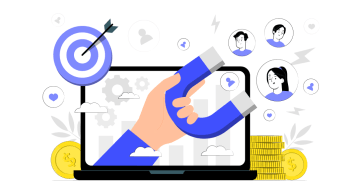Customer stories, Guides & best practices
View all articlesMastering B2B lead gen: lessons and insights from Jacobs Coffee

Lead generation is the top priority for more than 90% of marketers). But real success depends on those leads becoming customers, which is only possible if they are nurtured consistently. Pre-qualifying and segmenting leads efficiently is crucial for this. And it’s the only way for companies to ensure they speak to target groups with relevant, personalized content.
Interactive forms and A/B tests play a key role in increasing data quality and segmenting leads in a targeted manner. We spoke to marketing expert, Marin Wrede, from Jacobs, about how he improves lead quality, uses interactive forms as a lever for success, increases conversion rates, and gets leads ready to buy.
The caffeine kick for your performance marketing
Marin is the Performance Marketing Manager at Jacobs Douwe Egberts Services, the company behind Douwe Egberts coffee. His company offers coffee-as-a-service and sells coffee products, machines, and accessories to offices and companies in the DACH region – all completely digitally.
While his focus is on B2B lead generation, Marin also launched paid social recruitment campaigns at Jacobs when reinforcements were needed. 70 to 80 percent of employees at the digital subsidiary of Jacobs Douwe Egberts found their way into the company via this channel.
As a student, the performance expert launched the online marketing and e-commerce division of his family business, Wrede Verpackungen, from scratch. Today, he not only drives performance at Jacobs but is also self-employed and runs successful lead gen campaigns for his customers.
Generating B2B leads quickly and consistently
When Marin joined Jacobs in 2021, his first task was to automate the lead generation process. Back then, leads were still entered manually into the CRM system. Today, they come in automatically. For many companies, lead automation offers the greatest potential for better controlling and evaluating lead processes.
Greater efficiency also means faster response times and more deals: Conversion rates are eight times higher when leads are called back within five minutes. For Marin, every second counts, “We have optimized our processes so that it only takes a few minutes from the lead submission to our callback.”
Marin’s colleagues signed their quickest contract in just seven minutes. Their response time is so fast because they receive an audio alert and an email each time a new lead comes in.
Tip 1
Optimize your lead processes so you can contact and convert hot leads faster. “Speed is key, otherwise, leads will get colder and colder,” says Marin.

Saving time with a seamless lead journey
Along with speed, consistency is crucial to B2B lead gen success. While 79% of customers expect consistent interactions between departments like marketing and sales, 56% say they often have to repeat themselves or re-explain details. This often causes frustration.
“If the same person manages the process from first contact to signing the contract, and there are as few breaks in the journey as possible, this doesn't happen. Then you achieve consistency, which is particularly important for smaller companies,” says Marin.
Tip 2
Create a seamless lead journey. Smaller companies, in particular, will appreciate having a fixed contact person throughout the process so they don’t have to repeat their information several times.

What measures and channels work for B2B lead generation?
Marin uses a combination of push and pull channels to generate leads, including social ads and lead magnets for prospects actively seeking solutions. But there’s one channel that Marin says marketers should never go without: Google Ads.
Two-thirds of B2B decision-makers research online before making a purchase decision. Anyone who Googles “coffee machine for the office” is already showing a high level of intent, which Marin can serve directly with search ads. The channel can even be useful for niche B2B terms with a low search volume.
Convincing ad copy and landing pages where leads find what they’re looking for are key to successful Google or Meta ads. Although you can’t scale this channel indefinitely, Marin still recommends it at the beginning.
Tip 3
Start your lead gen process with ad campaigns. This makes it easier for leads already searching for products like yours to find your website.

➜ In our blog we show you 7 effective lead gen strategies
Evoke interest with lead magnets
96% of B2B companies use LinkedIn for organic content marketing. It’s the perfect place to pique the interest of your target group with relevant content, in the form of free whitepapers or studies, and point them to top-of-funnel webinars – where more than half of marketing decision-makers say they generate the most high-quality leads.

Marin explains that finding out which content works best takes trial and error. “First we tested content on one topic on LinkedIn, but we got the most leads with a whitepaper on a completely different topic that wasn't directly related to our product.”
This tells us that we shouldn’t assume the channel is ineffective just because a lead magnet isn’t delivering results. Often, the problem isn’t with LinkedIn, but with the content on offer. Maybe your target group prefers ebooks to video? Or perhaps they’re interested in a different topic area than the one you’ve covered in your whitepaper?
Tip 4
Be willing to experiment with your channels. If something doesn't work straight away, try out other approaches and content formats to find out what appeals to your audience.

Need ideas for your next lead magnet? ← Then this guide is for you.
Are lead portals a useful addition to lead gen workflows?
In addition to ad campaigns and content marketing, Marin has also tested lead portals as a source of new contacts. Lead brokers collect leads, pre-qualify them, and sell them. This might sound tempting for performance teams with tight budgets and little time. But is it worth it?
“The problem is that the competition can also use the leads from brokers,” says Marin. His recommendation: “I would rather build up my own lead database. It takes more time, but the leads are exclusive.”
Another advantage is that leads you’ve generated yourself are then more open to engaging because they’ve deliberately shared their contact details with you. If you collect and process data yourself, you will also retain it long-term, even if the lead broker no longer exists. And you can train your algorithm with your own data.
Tip 5
Generate your leads yourself instead of buying them in. Even if it means more effort in the short term, you’ll have more control in the long term and be able to generate high-quality leads in a targeted manner.

Increasing conversion rates with A/B tests
No matter the lead strategy or channels you choose, A/B testing is the key to increasing your conversion rates – according to Marin and 70 percent of marketers who prioritize regular testing.
In A/B testing, you pit two variants of a form or landing page against each other to identify the best performer and optimize your marketing measures based on data.
At Jacobs, for example, A/B tests have shown that leads convert better when suitable coffee machines are suggested to them without prices. “We used to give prices as a guide. But we found out through testing that more users complete the purchase if the price is only displayed at the very end,” says Marin.
He’s constantly making optimizations like these. “It’s only since implementing Heyflow that we’ve been able to make changes and carry out different kinds of tests without any coding experience,” says the performance expert.
➜ Not sure which elements you should test? Here are 7 ideas for your A/B testing in Heyflow.
How to use KPIs and metrics in your performance marketing
For your A/B tests to be successful, you need a clear strategy and reliable data – this is where KPIs and metrics come in. They help you monitor every stage of your funnel.
According to the Content Marketing Institute, the three most important B2B metrics include conversion rates, lead quality, and website engagement.
But what other metrics should you pay attention to? Marin gives us his recommendation and explains how he goes about it:
Click-through rate (CTR): After launching a new campaign, CTR is the first metric Marin looks at. It shows how many people click on the ad.
Conversion rate of lead forms: An important metric that measures the percentage of visitors who successfully complete and submit the form, compared to the total number of visitors who viewed the page. “Heyflow allows us to build multi-step forms and check how many users abandon on which page.”
Bounce rate: A high bounce rate can show that the landing page isn’t meeting user expectations. Using this data, Marin works out why users might be abandoning then tests his hypothesis. He decides how many percentage points he wants to improve the conversion by, and if he doesn’t hit his goal, he tests another possibility.
Once collected, leads need to be qualified. Marin differentiates between gross leads (all generated contacts) and net leads (qualified contacts).
This differentiation continues along the funnel. Marin checks, for example, the conversion rate of leads to opportunities, i.e. how many appointments are booked and actually taken up (the no-bid rate).
What should you bear in mind when analyzing these KPIs? Marin’s tip: “These metrics should never be viewed one-dimensionally, but always in connection with lead quality.”
Regardless of whether you monitor your metrics with Excel or a dashboard, it’s important to keep an eye on every funnel stage. “KPIs and A/B testing show you which adjustments can improve your performance. If you can optimize even just one percent at just one point, this will have an impact on the entire output.”
Tip 6
Break down your lead funnel into several stages and track the corresponding metrics. This allows you to identify weak points in the funnel and find out where you can optimize.

Of course, you also need to keep a close eye on costs as you go. Marin recommends tracking the following cost metrics:
Cost per lead (CPL): How much a generated lead costs is crucial for assessing the efficiency of the campaign budget. This metric is particularly helpful when budgets are limited or when scaling campaigns.
Cost per acquisition (CAC): In other words, the total cost required to acquire a paying customer. The CAC is also a key metric to evaluate profitability or ROI to ensure that the campaign is not only generating leads but also paying customers at a reasonable price.
LTV:CAC: The relationship between Lifetime Value (LTV) and CAC helps to assess long-term profitability, as well as the effectiveness and scalability of the overall marketing approach. If the LTV is significantly higher than the CAC, the campaign is sustainable.
Bonus tip
Use eye-tracking software like Microsoft Clarity or Hotjar to analyze how users interact with your page, what they look at first, and which parts they skip completely.

How to improve your lead quality
The success of a lead generation campaign stands and falls with the lead quality that comes out at the end. Pre-qualification is an important lever. But you should say goodbye to standard forms if you want to generate the right leads.
“With our own forms and the right questions, we can show expertise in our field and attract the right leads at the same time,” says Marin. For example, their forms don’t just ask how many employees a company has, but which specialty coffees they like and whether there’s a fixed water connection in the kitchen.
“Invest your time in good pre-qualification by asking specific questions. If you don't want to approach private individuals, for example, you should exclude private email addresses.”
Why does it make sense to apply exclusions at this early stage? By filtering out private individuals or unsuitable leads early in the funnel, you save lots of time and resources.
Tip 7
Ask relevant questions in your form to pre-qualify your leads. And if you can also demonstrate your specialist expertise at the same time, all the better.

“Your communication with Sales is also very important, because those colleagues often have the best feedback on whether a lead is actually relevant,” adds Marin.
5 levers for high-converting forms
Use these insights from Marin to collect the right B2B leads with your forms:
Don't ask too many questions. Work out what range works best for your target group. One HubSpot analysis found that in 40,000 forms examined, conversion rates were highest in forms with three and five questions.
Start with easy questions to get users into the flow quickly, so they’re more likely to stick with it and hit the “Submit” button.
The less personal data you ask for, the better. Reduce the contact fields to the bare essentials. In B2B, for example, a valid telephone number is most important.
Make sure your leads get what your form promises. If you offer a whitepaper, potential prospects should receive the download link immediately after filling it out.
Address the target group's pain points. Instead of advertising a new coffee machine, Jacobs shows that users can get coffee in the office faster in the morning because it doesn't take two hours to clean the machine.
Tip 8
Forms must suit the target group. The best forms are short, easy to understand, and show your leads why it's worth leaving their details.

➜ Find tips for better forms on our blog.
Exploiting the potential of the thank you page
One element that’s often overlooked, but can actually be a game changer, is the thank you page. Marin uses the page users see after submitting the form to show relevant information or additional content, and outline next steps.
At Jacobs, for example, leads are told that someone from the sales team will contact them by phone to discuss next steps. This makes the process more binding, sets timeline expectations, and builds trust.
Tip 9
Tell your leads what’s next once they submit your form. Clear information about the next steps reduces uncertainty and increases satisfaction, improving the chance of conversion.

What else could you display on the thank you page? Here are a few ideas from Marin:
A personalized message can increase trust in your company and improve lead engagement.
Links to success stories or testimonials. This type of social proof builds trust in your brand and motivates leads to stay active in the funnel.
An open field for feedback and comments. By collecting feedback, you can gain valuable insights into how your process or offer can be optimized.
From MQL to SQL: What happens to your leads?
Through A/B testing, optimized forms, and monitoring all funnel KPIs, Marin was able to improve and accelerate the lead process at Jacobs. But Marin's work is far from done. “As a performance manager, you hand over the lead the moment it becomes an opportunity. But not all leads become opportunities. This may be due to a lack of capacity in sales, for example, or because the competition has changed its prices,” explains Marin. In any case, it makes sense to analyze disqualified leads and lost opportunities, as unconverted leads provide valuable clues about why the process has come to a standstill.
“That's why close management of sales and collaboration is very important. You should talk to your colleagues in Sales, work with them to find solutions, and develop definitions,” advises Marin. Marketing and Sales often have different ideas about what constitutes a qualified lead. A common definition creates clarity and reduces misunderstandings.
Lots of companies haven’t implemented this yet. But we know that aligning marketing and sales is worthwhile, helping some B2B companies increase sales by over 200%.
Tip 10
The lead lifecycle doesn't end with the handover to Sales. Work together to turn leads into opportunities and ultimately into customers. You're all pursuing the same goal, after all.

Lead gen trends for B2B companies
B2B marketing is constantly evolving, with new lead gen trends emerging that have the potential to fundamentally change the way companies acquire customers. We spoke to Marin about which trends to keep an eye on and which will keep marketers busy in the coming years:
Lead funnel builder tools like Heyflow are increasingly helping B2B companies automate and optimize their lead generation.
With forms in quiz format, B2B companies are using the gamification trend to increase their interaction rate.
With two billion monthly users, WhatsApp is the largest messenger of all. And it’s set to continue shortening the interaction time with leads in B2B communication.
Due to compliance discussions about cookie-less tracking, zero-party data, which prospective customers provide voluntarily, is becoming increasingly relevant. According to Deloitte, 79% of users would share their data if they could derive clear added value from it.
McKinsey reports that a large percentage of generative AI’s potential $4.4 trillion economic value will come from marketing and sales. With its use in lead gen still limited, Marin says that gen AI could be used to maximize conversion rates by adapting questions in real time based on user behavior.
Conclusion
Lead generation is one of the hottest topics in B2B marketing and one that holds more potential than many companies currently are leveraging. If you want to reach potential customers, you need to focus on speed, relevant messages, and the right channels. Interactive forms, data-driven A/B tests, and a seamless transition between marketing and sales are all key levers.
Analyzing data helps you to better understand your target group and perfect your measures with A/B tests.
Marin's tried-and-tested tips will help you generate more leads and increase the quality of your contacts. This way, you can make sure your sales team only focuses on the most promising leads and that you maximize B2B marketing success in the long term.


